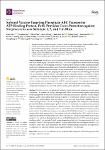Subunit Vaccine Targeting Phosphate ABC Transporter ATP-Binding Protein, PstB, Provides Cross-Protection against Streptococcus suis Serotype 2, 7, and 9 in Mice
| dc.contributor.author | Yan, Z | |
| dc.contributor.author | Yao, X | |
| dc.contributor.author | Pan, R | |
| dc.contributor.author | Zhang, J | |
| dc.contributor.author | Ma, X | |
| dc.contributor.author | Dong, N | |
| dc.contributor.author | Wei, J | |
| dc.contributor.author | Liu, K | |
| dc.contributor.author | Qiu, Y | |
| dc.contributor.author | Sealey, K | |
| dc.contributor.author | Nichols, H | |
| dc.contributor.author | Jarvis, Michael A | |
| dc.contributor.author | Upton, Mathew | |
| dc.contributor.author | Li, X | |
| dc.contributor.author | Ma, Z | |
| dc.contributor.author | Liu, J | |
| dc.contributor.author | Li, B | |
| dc.date.accessioned | 2023-04-17T10:56:45Z | |
| dc.date.issued | 2023-01-09 | |
| dc.identifier.issn | 2306-7381 | |
| dc.identifier.uri | https://pearl.plymouth.ac.uk/handle/10026.1/20712 | |
| dc.description.abstract |
Streptococcus suis is a significant pathogen in pigs and a newly emerging zoonotic agent in humans. The presence of multiple serotypes and strains with diversified sequence types in pig herds highlights the need for the identification of broadly cross-reactive universal vaccine antigen targets, capable of providing cross-protection against S. suis infection. Subunit vaccines based on the conserved proteins shared between different S. suis serotypes are potential candidates for such a universally protective vaccine. In the present study, phosphate ABC transporter ATP-binding protein PstB (PstB), an immunogenic protein of the S. suis bacterium, was expressed and purified, and then subjected to cross-protection evaluation in mice. The PstB protein showed nearly 100% amino acid similarity across a panel of 31 S. suis isolates representing different serotypes, which were collected from different countries. A recombinant PstB (rPstB) protein (S. suis serotype 2) was recognized by rabbit sera specific to this serotype, and induced high levels of IFN-γ and IL-4 in mice immunized with the recombinant protein. These cytokines are considered important for protection against S. suis infection. Immunization of mice with rPstB resulted in an 87.5% protection against challenge with S. suis serotype 2 and 9 strains, suggesting a high level of cross-protection for S. suis serotypes 2 and 9. A lower protection rate (62.5%) was observed in mice challenged with the S. suis serotype 7 strain. These data demonstrate that PstB is a promising target antigen for development as a component of a universal subunit vaccine against multiple S. suis serotypes. | |
| dc.format.extent | 48-48 | |
| dc.language | en | |
| dc.publisher | MDPI AG | |
| dc.title | Subunit Vaccine Targeting Phosphate ABC Transporter ATP-Binding Protein, PstB, Provides Cross-Protection against Streptococcus suis Serotype 2, 7, and 9 in Mice | |
| dc.type | journal-article | |
| plymouth.issue | 1 | |
| plymouth.volume | 10 | |
| plymouth.journal | Veterinary Sciences | |
| dc.identifier.doi | 10.3390/vetsci10010048 | |
| plymouth.organisational-group | |Plymouth | |
| plymouth.organisational-group | |Plymouth|Research Groups | |
| plymouth.organisational-group | |Plymouth|Faculty of Health | |
| plymouth.organisational-group | |Plymouth|Research Groups|Institute of Translational and Stratified Medicine (ITSMED) | |
| plymouth.organisational-group | |Plymouth|Research Groups|Institute of Translational and Stratified Medicine (ITSMED)|CBR | |
| plymouth.organisational-group | |Plymouth|REF 2021 Researchers by UoA | |
| plymouth.organisational-group | |Plymouth|Users by role | |
| plymouth.organisational-group | |Plymouth|Users by role|Academics | |
| plymouth.organisational-group | |Plymouth|REF 2021 Researchers by UoA|UoA01 Clinical Medicine | |
| plymouth.organisational-group | |Plymouth|Faculty of Health|School of Biomedical Sciences | |
| plymouth.organisational-group | |Plymouth|Users by role|Researchers in ResearchFish submission | |
| plymouth.organisational-group | |Plymouth|Research Groups|Plymouth Institute of Health and Care Research (PIHR) | |
| dcterms.dateAccepted | 2023-01-05 | |
| dc.date.updated | 2023-04-17T10:56:40Z | |
| dc.rights.embargodate | 2023-4-18 | |
| dc.identifier.eissn | 2306-7381 | |
| rioxxterms.versionofrecord | 10.3390/vetsci10010048 |


